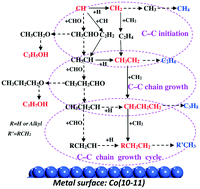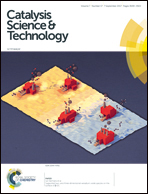Insight into the preferred formation mechanism of long-chain hydrocarbons in Fischer–Tropsch synthesis on Hcp Co(10−11) surfaces from DFT and microkinetic modeling†
Abstract
DFT calculations, together with microkinetic modeling, have been employed to probe into the preferred mechanism of hydrocarbon C–C chain growth on Co(10−11) surfaces during Fischer–Tropsch synthesis. The results show that both CH and CH2 are favored CHx (x = 1–3) monomers, and are much easier to be formed than CH4 and CH3OH. CH and CH2 self-coupling via a carbide mechanism realizes the initial C–C chain formation, rather than via a CO/CHO insertion mechanism. Meanwhile, CH3CH2 is the favored C2 monomer, and is predominantly formed via a carbide mechanism rather than via a CO/CHO insertion mechanism, leading to C2H5OH formation. Starting from CH3CH2 intermediates, CH3CH2 coupling with CH2 to form CH3CH2CH2 realizes further C–C chain growth from C2 to C3 species, instead of a CO/CHO insertion mechanism leading to C3H7OH formation. Thus, the proposed mechanism of C–C chain growth is that RCH2CH2 coupling with CH2 to R′CH2CH2 (R′ = RCH2) realizes C–C chain growth. Meanwhile, CHO insertion into RCH2CH leads to RCH2CHCHO, followed by its hydrogenation to an alcohol. However, microkinetic modeling shows that the effect of CH4 formation on the production of C2+ hydrocarbons should be considered, whereas alcohols have a negligible effect on the selectivity of C2+ hydrocarbons. Our results confirm that Co(10−11) surfaces exhibit a better catalytic activity and selectivity toward C2+ hydrocarbon formation.



 Please wait while we load your content...
Please wait while we load your content...